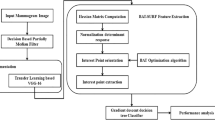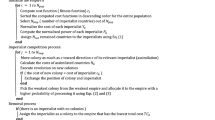Abstract
In recent times, Medical Information and Processing deals with various methodologies utilized for the prognosis and diagnosis of various harmful diseases with the help of trending artificial intelligence and machine learning techniques. Breast cancer is one of such disease which occupies the major share in killing the millions of people especially women. Several intelligent methods were proposed for an efficient diagnosis of breast cancer, but brighter light of research is required for better diagnosis. Hence the new methodology of integrating the run length features along with the Bat optimized learning Machines—BORN has been proposed. BORN also features the most efficient visual saliency segmentation process to obtain highly efficient diagnosis. The main aim of the proposed BORN algorithm is to diagnosis the different stages of breast cancer with high accuracy and minimal error. For attaining the high accuracy, BORN has been tested with two different datasets MIAS and DDSM with different learning kernels and compared with the other intelligent algorithms such as RF-ELM, EGAM and Associate Classifiers in which accuracy of the proposed classifier is 99.5%.












Similar content being viewed by others
Change history
14 June 2022
This article has been retracted. Please see the Retraction Notice for more detail: https://doi.org/10.1007/s12652-022-04151-x
References
Abu-Amara F, Abdel-Qader I (2009) Hybrid mammogram classification using rough set and fuzzy classifier. Int J Biomed Imaging. https://doi.org/10.1155/2009/680508
AlQoud A, Arfan Jaffar M (2016) Hybrid gabor based local binary patterns texture features for classification of breast mammograms. Int J Comput Sci Netw Secur 16(2):16–21
Deshmukh J, Bhosle U (2017) GLCM based improved mammogram classification using associative classifier. In: I. J. Image, Graphics and Signal Processing, 2017, 7, 66–74 Published Online July 2017 in MECS
Eltoukhy MM, Elhoseny M, Hosny KM, Singh AK (2018) Computer aided detection of mammographic mass using exact Gaussian-Hermite moments. J Ambient Intell Humaniz Comput. https://doi.org/10.1007/s12652-018-0905-1
Gahirwal M, Swita F, Kanchan M, Neha N, Aditi P (2018) Early diagnosis of breast cancer using SVM. Int J Innov Res Comput Commun Eng 6(2):749–756
Gardezi SJS, Awais M, Faye I, Meriaudeau F (2017) Mammogram Classification using Deep learning features” 2017 IEEE International Conference on Signal and Image Processing Applications (ICSIPA), 01 December 2017
Ghongade RD, Wakde DG (2018) Breast cancer diagnosis from digital mammograms using RF and RF-ELM. In: Proceedings of international conference on recent advancement on computer and communication, pp 365–374
Huang G-B, Zhu Q-Y, Siew C-K (2006) Extreme learning machine: theory and applications. Neurocomputing 70(1):489–501
Jaffar MA (2017) Hybrid texture-based classification of breast mammograms using adaboost classifier. Int J Adv Comput Sci Appl 8(5):321–327
Khan K, Sahai A (2012) A comparison of ba, ga, pso, bp and lm for training feed forward neural networks in e-learning context. Int J Intell Syst Appl (IJISA) 4(7):23
Langarizadeh M, Mahmud R, Ramli AR, Napis S, Beikzadeh MR, Rahman WE (2011) Improvement of digital mammogram images using histogram equalization, histogram stretching and median filter 35(2):103-8. https://doi.org/10.3109/03091902.2010.542271 (Epub 2011 Jan 4)
Lu S, Lu Z (2016) A pathological brain detection system based on kernel-based EL. Multimed Tools Appl 77:3715–3728
Mohamed SE, Wahbi TM, Sayed MH (2018) Automated detection and classification of breast cancer using mammography images. Int J Sci Eng Technol Res 7(4):209–216
Murali S, Kumar PS (2015) Multiclass classification of mammogram images with GLCM features. Int J Eng Res Sci Technol 1:56–62
Pérez M, Benalcázar ME, Tusa E, Rivas W, Conci A (2018) Mammogram classification using back propagation neural networks and texture features descriptors. In: 2017 IEEE second ecuador technical chapters meeting (ETCM)
Ren J, Wang D, Jiang J (2011) Effective recognition of MCCs in mammograms using an improved neural classifier. Eng Appl Artif Intell 24:638–645
Selvi C, Suganthi M (2018) A novel enhanced gray scale adaptive method for prediction of breast cancer. J Med Syst 42:221. https://link.springer.com/article/10.1007%2Fs10916-018-1082-7. Accessed Oct 2018
Sim HL, Seah M, Tan SM (2009) Breast cancer knowledge and practices: a survey of 1000 Asian women. Singapore Med J 50(2):132–138. https://www.ncbi.nlm.nih.gov/pubmed/19296027. Accessed Mar 2009
Singh AS, Pawar MM (2017) Mass classification of mammogram images using selected textural features with PNN classifier. In: International journal of innovative research in computer and communication engineering, vol 5, Special Issue 4
Surendiran, Vadivel A (2011) A hybrid classifier for mammogram mass classification using various new geometric shape and margin features. Int J Rapid Manuf 2(1/2):56–75
Swiniarski R, Lim HK (2003) Independent component analysis, principal component analysis and rough sets in hybrid mammogram classification. In: International (SPIE) symposium medical imaging
Tavakoli N, Karimi M, Norouzi A, Karimi N, Samavi S, Soroushmehr SMR (2019) Detection of abnormalities in mammograms using deep features. J Ambient Intell Humaniz Comput. https://doi.org/10.1007/s12652-019-01639-x
Wan J, Lan Y, Zhao R, Wu Y (2013) Mammographic mass segmentation using variational method. Int Conf Intell Human-Mach Syst Cybern 2:135–138
Wang Z, Yu G, Kang Y, Zhao Y, Qu Q (2014) Breast tumor detection in digital mammography based on extreme learning machine. Neurocomputing 128:175–184
Wang B, Huang S, Qiu J et al (2015) Parallel online sequential extreme learning machine based on Map Reduce. Neurocomputing 149:224–232
Wang H, Feng J, Bu Q, Liu F, Zhang M, Ren Y, Lv Y (2018) Breast mass detection in digital mammogram based on gestalt psychology. J Healthc Eng. https://doi.org/10.1155/2018/4015613
Yang X-S, He X (2013) Bat algorithm: literature review and applications. Int J Bio-Inspired Comput 5(3):141–149
Zhang P, Kumar K, Verma B (2005) A hybrid classifier for mass classification with different kinds of features in mammography. In: Lecture notes in computer science, vol 3614, No. PART II, pp 316–319
Zhou W, Lv G, Wang L (2017) An automatic breast mass segmentation algorithm in digital mammography. In: IEEE international conference on signal processing, communications and computing, pp 1–5
Zhu W, Xiang X, Tran TD, Hager GD, Xie X (2018) Adversarial deep structured nets for mass segmentation from mammograms. In: International symposium on biomedical imaging, pp 4–7
Author information
Authors and Affiliations
Corresponding authors
Additional information
Publisher's Note
Springer Nature remains neutral with regard to jurisdictional claims in published maps and institutional affiliations.
This article has been retracted. Please see the retraction notice for more detail: https://doi.org/10.1007/s12652-022-04151-x
About this article
Cite this article
Nirmala, G., Suresh Kumar, P. RETRACTED ARTICLE: A novel bat optimized runlength networks (BORN) for an efficient classification of breast cancer. J Ambient Intell Human Comput 12, 4797–4808 (2021). https://doi.org/10.1007/s12652-020-01890-7
Received:
Accepted:
Published:
Issue Date:
DOI: https://doi.org/10.1007/s12652-020-01890-7




